Gubbins D., Herrero-Bervera E. Encyclopedia of Geomagnetism and Paleomagnetism
Подождите немного. Документ загружается.


Fabian, K., 2000. Acquisition of thermoremanent magnetization in
weak magnetic fields. Geophysical Journal International, 142:
478–486.
Fox, J.M.W., and Aitken, M.J., 1980. Cooling-rate dependence of ther-
moremanent magnetisation. Nature, 283: 462–463.
Halgedahl, S.L., and Fuller, M., 1980. Magnetic domain observations
of nucleation processes in fine particles of intermediate titanomag-
netite. Nature, 288:70–72.
Halgedahl, S.L., and Fuller, M., 1983. The dependence of magnetic
domain structure upon magnetization state with emphasis on
nucleation as a mechanisms for pseudo-single-domain behaviour.
Journal of Geophysical Research, 88: 6506–6522.
Halgedahl, S.L., Day, R., and Fuller, M., 1980. The effect of cooling
rate on the intensity of weak-field TRM in single domain magne-
tite. Journal of Geophysical Research, 85: 3690–3698.
Heider, F., Halgedahl, S.L., and Dunlop, D.J., 1988. Temperature
dependence of magnetic domains in magnetite crystals. Geophysi-
cal Research Letters, 15: 499–502.
McClelland, E., and Sugiura, N., 1987. A kinematic model of TRM
acquisition in multidomain magnetite. Physics of the Earth and
Planetary Interiors, 46:9–23.
Menyeh, A., and O’Reilly, W., 1998. Thermoremanence in monoclinic
pyrrhotite particles containing few domains. Geophysical Research
Letters, 25(18): 3461–3464.
Metcalf, M., and Fuller, M., 1987. Domain observations of titanomag-
netites during hysteresis at elevated temperatures and thermal
cycling. Physics of the Earth and Planetary Interiors, 46:
120–126.
Néel, L., 1949. Théorie du traînage magnétique des ferromagnétiques
en grains fins avec applications aux terres cuites. Annales de Geo-
physique, 5:99–136.
Néel, L., 1955. Some theoretical aspects of rock magnetism. Advances
in Physics, 4: 191–243.
Özdemir, Ö., and Dunlop, D.J., 1997. Effect of crystal defects and
internal stress on the domain structure and magnetic properties of
magnetite. Journal of Geophysical Research, 102:20211–20224.
Özdemir, Ö., and Dunlop, D.J., 2002. Thermoremanence and stable
memory of single-domain hematite. Geophysical Research Letters,
29:doi:10.1029/2002GL015597.
Özdemir, Ö., and O’Reilly, W., 1982. An experimental study of ther-
moremanent magnetization acquired by synthetic monodomain
titanomaghemites. Journal of Geomagnetism and Geoelectricity,
34: 467–478.
Schmidt, V.A., 1973. A multidomain model of thermoremanence.
Earth and Planetary Science Letters, 20: 440–446.
Shcherbakov, V.P., McClelland, E., and Shcherbakova, V.V., 1993. A
model of multidomain thermoremanent magnetization incorporat-
ing temperature-variable domain structure. Journal of Geophysical
Research, 98: 6201–6216.
Stacey, F., 1958. Thermoremanent magnetization (TRM) of multi-
domain grains in igneous rocks. Philosophical Magazine, 3:
1391–1401.
Stacey, F., and Banerjee, S.K., 1974. The Physical Principles of Rock
Magnetism. Elsevier, Amsterdam.
Stoner, E.C., and Wohlfarth, E.P., 1948. A mechanism of magnetic
hysteresis in heterogeneous alloys. Philosophical Transactions of
the Royal Society of London, A240: 599– 642.
Sugiura, N., 1980. Field dependence of blocking temperature of
single-domain magnetite. Earth and Planetary Science Letters,
46: 438–442.
Thellier, E., 1938. Sur l’aimantation des terres cuites et ses applica-
tions géophysiques. Annales de. l’Institut de Physique du Globe,
Université de Paris, 16: 157–302.
Thellier, E., and Thellier, O., 1959. Sur l’ intensité du champ magné-
tique terrestre dans le passé historique et géologique. Annales de
Géophysique, 15: 285–376.
Tucker, P., and O’Reilly, W., 1980. The acquisition of thermoremanent
magnetization by multidomain single-crystal titanomagnetite. Geo-
physical Journal of the Royal Astronomical Society,
60:21–36.
Winklhofer, M., Fabian, K., and Heider, F., 1997. Magnetic blocking
temperatures of magnetite calculated with a three-dimensional
micromagnetic model. Journal of Geophysical Research, 102:
22695–22709.
Cross-references
Archeomagnetism
Magnetic Anisotropy, Sedimentary Rocks and Strain Alteration
Magnetic Domain
Magnetic Susceptibility
Magnetization, Chemical Remanent (CRM)
Magnetization, Isothermal Remanent (IRM)
Magnetization, Natural Remanent (NRM)
Magnetization, Viscous Remanent (VRM)
MAGNETIZATION, THERMOREMANENT, IN
MINERALS
Thermoremanent magnetization
Perhaps the best understood of the primary magnetizations, of natural
rocks and specimens, is thermal remanent magnetization (TRM). Most
of the natural rocks are magnetized primarily by the geomagnetic field
(30000 nT) and acquire natural remanent magnetization (NRM).
Magnetic minerals acquire TRM when they are contained within the
rock that is cooled in an external magnetic field from temperatures
above the minerals’ blocking temperatures. Blocking of remanent
magnetization at a specific temperature results in locking of a specific
direction and intensity of magnetization as it becomes stable on the
timescale of the TRM acquisition.
The generally recognized first-order theory of TRM can be applied
only to small uniformly magnetized grains (Néel, 1949) and it provides
a reasonable explanation for the intensity of TRM vs inducing field. The
theory explains the changes of stability of TRM with temperature and
with the inducing field, explaining how a rock can maintain a TRM
record for billions of years. This theory can also provide an explanation
on how the secondary component of magnetization of a rock can be
removed from the primary one.
However, besides being useful only for small single-domain (SD)
grains it is also less successful in explaining TRM acquisition for more
intense ambient fields (1 mT). According to Neel’s theory, the TRM
reaches saturation, in lower fields than actually measured on speci-
mens (10 mT). This effect was assigned to particle interaction and
long axis dispersions (Stacey and Banerjee, 1974).
In general, the TRM is not carried only by a small single-domain
(SD) fraction of magnetic mineral grains. When the volume of the
grain is larger (>0.5 m m for magnetite mineral) the demagnetizing
field (caused by magnetic sources distributed on the surface of the
grain) has a slightly different geometry than the pattern of the uniform
magnetization (Figure M135). This geometry causes inhomogeneity of
magnetization of the larger grains that is replaced by more energeti-
cally favorable state containing domain walls bounding volume with
reversed magnetic moments.
Neel first attempted to construct the theory for multidomain materi-
als (Néel, 1955). Stacey (1963) and Everitt (1962) applied a concept of
Barkhausen discontinuities, small jumps of the domain walls into the
new position, believed to be due to crystal imperfections. The resis-
tance of the domain wall motion was thought to be responsible for
remanent magnetism in MD grains. As the smaller MD grains were
616 MAGNETIZATION, THERMOREMANENT, IN MINERALS
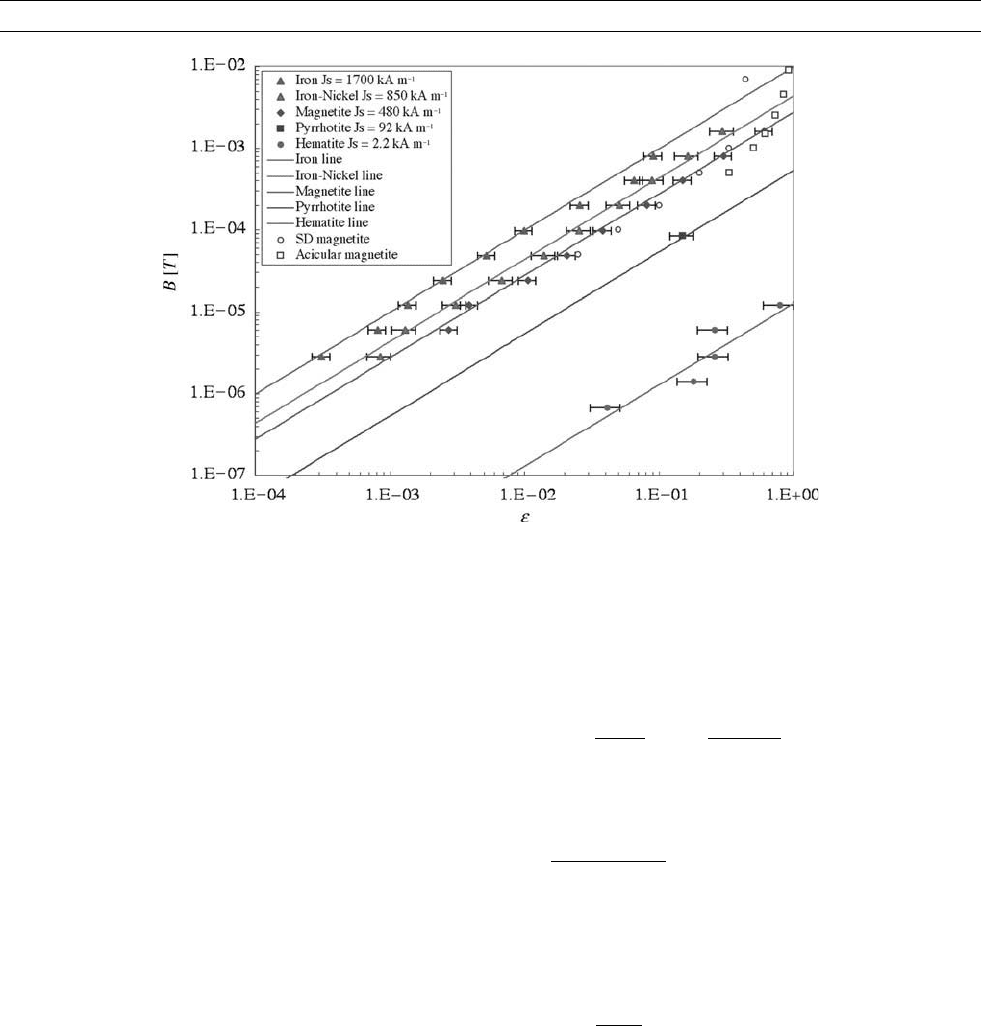
more stable than larger MD grains, Stacey invented the term pseudo-
single-domain (PSD) grains for grains slightly larger than SD grains
(Stacey, 1963).
Because, in general, small grains of magnetite have 2–3 orders of
magnitude larger TRM intensity than larger MD grains. For some time
it was thought that the TRM of MD grains is negligible (Hargraves and
Young, 1969; Hoye and Evans, 1975). More small grains are present
in rocks than apparently visible, resulting from the formation of the
iron oxides through oxidation inside the silicates.
The intensity of the remanent magnetization acquired by rocks is
determined by an unknown strength of the ambient magnetic field,
an unknown magnetic mineral composition, and an unknown tempera-
ture history of the sample. Stacey pointed out in his theory of multido-
main TRM (Stacey, 1958) that because the demagnetizing energy falls
off more slowly with temperature than any other, the condition under
which TRM is first acquired is simply the minimization of the internal
field. This guarantees that at least at this temperature the TRM is
related only to the magnetostatic energy and the demagnetizing energy.
Néel’s theory of MD TRM is incomplete since it fails to describe many
aspects of pTRM (partial TRM) behavior (Néel, 1955; Shcherbakova
et al., 2000). There the blocking occurs at temperature T
b
when mag-
netic coercivity increases high enough to pin domain walls against the
demagnetizing field. For TRM of SD grains at room temperature,
M
tr
(T
r
), magnetic remanence was frozen in high temperature equili-
brium distribution achieved by thermally excited transitions among
the different magnetic states. Transitions cease below the T
b
, because
in the course of cooling, the energy barriers between different magne-
tization states grow larger than the available thermal energy. For both
SD and MD states the resulting magnetization, composed of many
magnetic moments, is in the direction of and for mineral specific field
range (Kletetschka et al., 2004) proportional to the applied magnetic
field B. Efficiency e(T
r
)ofM
tr
(T
r
) of SD grains of saturation rema-
nence J
sr
(T
r
), volume V, and saturation magnetization J
s
(T
b
) is (Néel,
1949):
EðT
r
Þ¼
M
tr
ðT
r
Þ
J
sr
ðT
r
Þ
¼ tanh
mVJ
s
ðT
b
ÞB
kT
b
; (Eq. 1)
with m
0
¼ 4p 10
–7
, and k ¼ 1.38 10
–23
JK
–1
.
On the timescale 50–100 s:
m
0
VJ
s
ðT
b
ÞB
c
ðT
b
Þ
kT
b
¼ 2lnðf
0
tÞ50;
where B
c
(T
b
) is a critical field for moment rotations in the absence of
thermal energy (microcoercivity), and frequency of moment fluc-
tuation f
0
10
9
s
1
. Therefore, from Eq. (1) one can derive for
small fields (E 1):
EðT
r
Þ¼
50B
B
c
ðT
b
Þ
(Eq. 2)
In most fine-grained magnetic material, a typical efficiency E(T
r
)ofther-
moremanent magnetization M
tr
(T
r
) acquired in the geomagnetic field is
about 1% (Wasilewski, 1977, 1981; Cisowski and Fuller, 1986;
Kletetschka et al., 2000a). This small efficiency is consistent with the
M
tr
(T
r
) acquisition curves for magnetite (Dunlop and Waddington, 1975;
Tucker and O’Reilly, 1980; Özdemir and O’Reilly, 1982) with grain sizes
covering the range from the single-domain (SD) to multidomain (MD)
magnetic states. However, M
tr
(T
r
) experiments with hematite (Kletetschka
et al., 2000b,c; Dunlop and Kletetschka, 2001; Kletetschka et al., 2002)
showed e >10%.
Experimental TRM constrains for theory
The following part is largely reiteration of the results from Kletetschka
et al. (2004). There in an attempt to reconcile the contrast between
TRM acquisition of hematite and magnetite series of magnetic M
tr
Figure M135 Intensities of the ambient magnetic field B (tesla) against thermoremanent efficiencies e of hematite (Fe
2
O
3
), magnetite
(Fe
3
O
4
), iron-nickel alloy (FeNi) and iron (Fe). The pyrrhotite data (Fe
7
S
8
) are from Dekkers (1989). Straight lines are drawn
according to B ¼ aJe , where a is a dimensionless constant equal to 0.0046 (see Figure M137a) at 300 K, and J ¼ m
0
J
s
where
m
0
is permeability of vacuum and J
s
is saturation magnetization at 300 K. Magnetization efficiency e is defined as e ¼ M
tr
=J
sr
, the
ratio of thermoremanence to saturation remanence. Single-domain (SD) and acicular (elongated crystal parallel to the applied field)
magnetite data are redrawn from Dunlop and Argyle (1997) and Dunlop and West (1969), respectively.
MAGNETIZATION, THERMOREMANENT, IN MINERALS 617
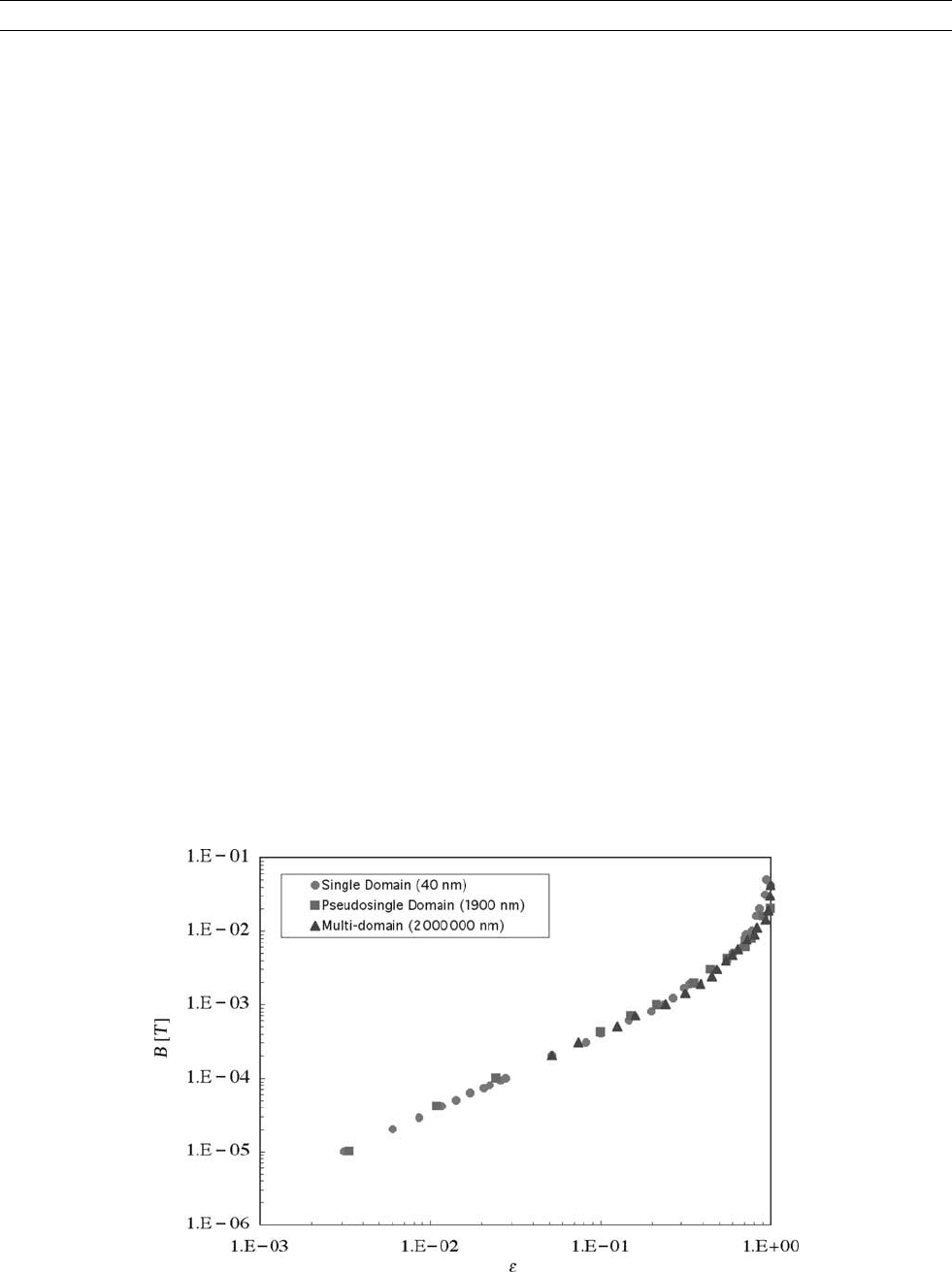
acquisitions performed using distinct magnetic materials (Kletetschka
et al., 2004): iron (Fe), iron-nickel (FeNi), magnetite (Fe
3
O
4
), hematite
(a-Fe
2
O
3
), and resistance wires MWS-294R and ALLOY52. Figure
M135 shows the field B required to reach efficiency E(T
r
) of the M
tr
(T
r
)
acquisition for equidimensional samples and a literature sample of aci-
cular magnetite (Dunlop and Argyle, 1997) in which the crystals are
highly elongated parallel to the applied field. Data near and at satura-
tion, where the simple power law breaks down (see Figure M136),
were excluded from the data set. The data set includes literature data
for pyrrhotite (Dekkers, 1989). Remarkably, each mineral is restricted
to its own line with the unit slope in the logB-logE space. Another
important feature reported in Kletetschka et al. (2004) is that the larger
the J
s
(T
r
) (see legend) the larger the field B required to achieve a pre-
defined efficiency level E.
An increase of the minerals’ J
s
(T
r
) is equivalent to a similar increase
in opposing demagnetizing field H
d
(T
r
) (Dunlop and Özdemir, 1997;
Kletetschka et al., 2000b, c; Dunlop and Kletetschka, 2001) as well
as critical fields B requiring material to reach the saturation magnetiza-
tion at T
b
. The demagnetizing field at saturation relates to B
c
(T
b
),
above which the energy minima become unstable causing the magnetic
moment to irreversibly rotate in an absence of thermal fluctuations.
Low J
s
(T
r
) value is associated with low value of both B
c
(T
b
) and H
d
and leads to a large critical SD size and large magnetic domain wall
spacing while large J
s
(T
r
) implies large B
c
(T
b
) (or H
d
) causing a fine
scale of the individual domains. Other effects, like magnetostriction,
anisotropy, and exchange constants, may also cause changes in the
overall magnetic domain size.
Data in Figure M135 are representative of multidomain (MD)
magnetic materials (1 mm grain size). However, the M
tr
(T
r
) varies with
the grain size according to the domain type (Kletetschka et al., 2004).
For example, MD magnetite has M
tr
(T
r
) that increases with decreasing
grain size (Dunlop, 1990). Similar grain size dependence has been
observed at saturation for J
sr
(T
r
) (Dunlop, 1990) (E ¼1). Thus, efficiency
E(T
r
)ofM
tr
(T
r
) rather than just M
tr
(T
r
) reduces the grain size dependence
to a minimum, and a line separation in the logB-logE plot can be used to
identify the magnetic mineralogy in ideal circumstances.
The insensitivity of the logB-logE(T
r
) plot to various grain sizes
is illustrated in Figure M135, where the M
tr
(T
r
) efficiency for SD
magnetite (literature data; Dunlop and Argyle, 1997) correlates with
MD magnetites; this breaks down when mineral size becomes so small
that it is near or in the superparamagnetic size range (Dunlop and
Argyle, 1997). The grain size independence is resolved in Figure
M136 where we have literature data of various M
tr
(T
r
) acquisitions
of titanomagnetite with disparate magnetic domain states identified
by the specific grain sizes (Dunlop and Waddington, 1975; Tucker
and O’Reilly, 1980; Özdemir and O’Reilly, 1982). Despite much
stronger M
tr
(T
r
) of fine vs large magnetic grains, all sizes appear to
have identical acquisitions when normalized by saturation remanence
J
sr
(T
r
).
When neglecting effects near saturation (E < 0.3), this linear depen-
dence predicts approximate maximum values of the magnetic field
that can be recorded by a specific material (Figure M135). Near the
saturation, the magnetization is not linear with the applied field
(Figure M136) owing to Eq. (1) when E 1. Thus, the magnetic fields
at which E 1 should be the magnetic fields that define the values of
intrinsic B
c
(T
b
) for the specific mineral. Knowledge of B
c
(T
b
)fieldsin
principle can be used for dating of the magnetization according to
known magnetization viscous decay curves (Heller and Markert, 1973;
Borradaile, 1996). B
c
1 M
s
for shape anisotropy, B
c
/ l
M
n
s
for mag-
netoelastic anisotropy (Syono and Ishikawa, 1963b; Moskowitz, 1993)
(for n > 2) and B
c
1K
M
n
s
for crystalline anisotropy (Syono and Ishi-
kawa, 1963a; Fletcher and O’Reilly, 1974) (for n > 8) where n is the
experimentally determined exponent. Both K and l go to zero much fas-
ter than M
s
when approaching Curie temperature T
c
.Energyminimum,
related to magnetic ordering, becomes shallower when approaching
T
b
due to thermal fluctuations (Stacey, 1958). Thus, for the purpose
of magnetic remanence blocking near T
c
we may consider only the
shape anisotropy: B
k
1 M
s
. The distribution of demagnetization field
vectors (tensors in general; Dunlop and Özdemir, 1997) relates to
B
c
(T
b
), the nature of the resulting M
tr
(T
r
) and the E (T
r
) dependen-
cies. The B
c
(T
b
) fields are small in minerals with low J
s
(T
r
)causing
them to reach saturation (E(T
r
) ¼ 1) in much lower applied fields B
Figure M136 Acquisition fields are plotted against thermoremanent efficiency for contrasting domain states of titanomagnetite. Data for
multidomain and pseudosingle-domain mineral are from Tucker and O’Reilly (1980). Data for single-domain minerals are from
O
¨
zdemir and O’Reilly (1982).
618 MAGNETIZATION, THERMOREMANENT, IN MINERALS
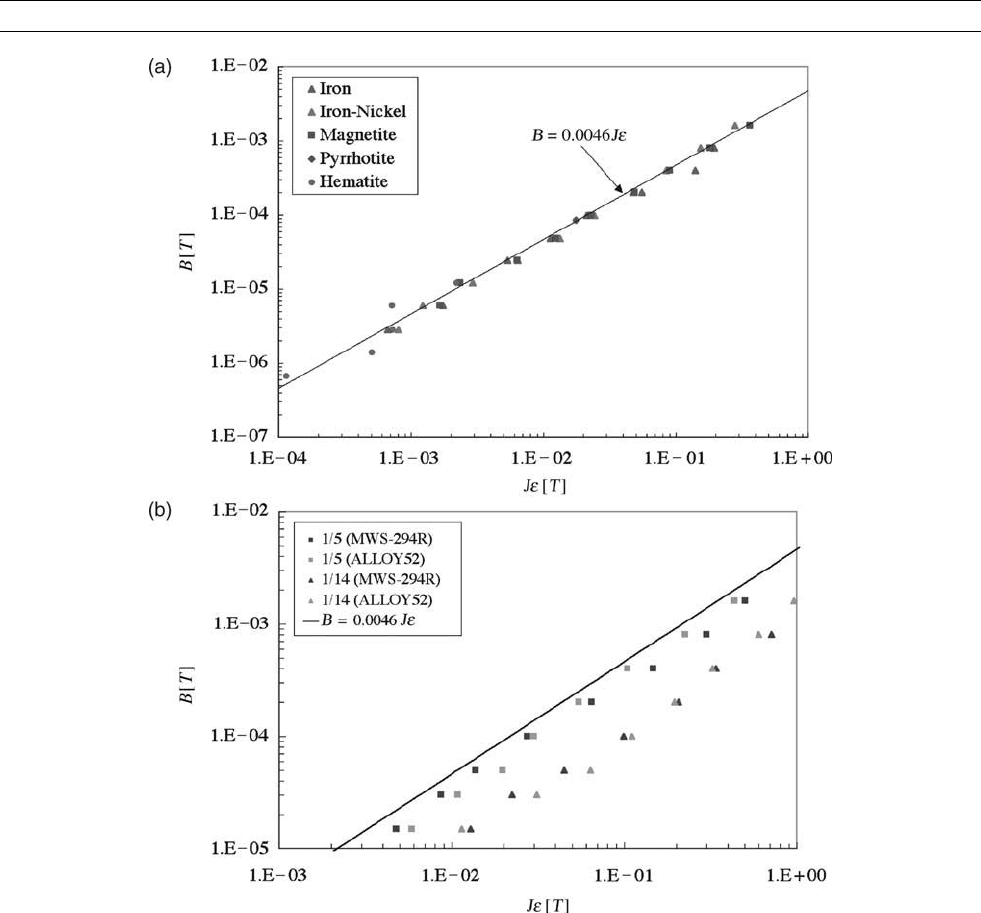
(Kletetschka et al., 2000c; Dunlop and Kletetschka, 2001). Larger
B
c
(T
b
) in minerals with large J
s
(T
r
) creates larger resistance against
acquisition of M
tr
(T
r
) and requires larger magnetizing fields to
achieve the saturation (E(T
r
) ¼ 1). For example, because magnetoelas-
tic and crystalline constants go to zero much faster than M
s
close to
T
C
, hematite has low B
c
(T
b
) (due to shape anisotropy) at the point at
which TRM is acquired in contrast to its high B
c
at room tempera-
ture caused by high magnetoelastic anisotropy.
The fundamental role of J
s
(T
r
) in mineral specific M
tr
(T
r
) acquisition
can be crystal clear by taking the data from Figure M135, multiplying
the magnetic efficiency E(T
r
)byJ(T
r
) ¼ m
0
J
s
(T
r
)(Figure M137a).
Remarkably the resulting data set completely eliminates the effect of
the demagnetizing field during the M
tr
(T
r
) acquisition. Figure M137a
suggests that mineral M
tr
(T
r
) acquisitions can be in general approxi-
mated (linear regression coefficient R ¼ 0.97) by following a linear fit:
B ¼ aðTÞJ ðT ÞEðT
r
Þ; (Eq. 3)
where a ¼ (4.6 0.3) 10
3
with 95% confidence level for T ¼ T
r
¼
300 K. The product J
s
(T
r
)E(T
r
) is essentially the M
tr
(T
r
) normalized by
the squareness ratio J
sr
(T
r
)/J
s
(T
r
) of the hysteresis loop. This linear beha-
vior (Figure M137a) indicates that all magnetic minerals should contri-
bute to a planetary thermoremanent magnetic anomaly (e.g., intense
magnetic anomalies detected on Mars (Acuña et al., 1999) with the same,
squareness J
sr
(T
r
)/J
s
(T
r
)-normalized, M
tr
(T
r
) intensity. Because J
s
(T
r
)
Figure M137 Magnetic acquisition fields are plotted against JE, which is the saturation magnetization J ¼ m
0
J
s
multiplied by efficiency
E of various materials at 300 K. (a) Equidimensional grains of iron, iron-nickel, magnetite, pyrrhotite, and hematite define a straight
line that is a result of a linear fit to all of the data. For J
s
at 300 K this fit has the form of B ¼ (4.6 0.3) 10
–3
JE. The linear
regression coefficient is R ¼ 0.97. (b) Effect of shape (nonequidimensional crystals) on thermoremanent acquisition fields for
wire materials (MWS-294R and ALLOY52) with small (1/5) and large (1/14) predefined length to diameter ratios compared with the
predicted acquisition (solid line) for equidimensional materials. Measurements were made with wires aligned parallel to the
applied field.
MAGNETIZATION, THERMOREMANENT, IN MINERALS 619

eliminates the mineral dependence observed in Figure M135 produced
byvariation in B
c
(T
b
) in different minerals, B
c
(T
b
) ¼ 0.23J
s
(T
r
)in
Eq. (2) leads to the empirically observed relationship equation (3). Equa-
tion (3) breaks down if the Curie temperature of the magnetic material
gets near or below 300 K. With decreasing temperature, J
s
increases
and reaches a maximum at absolute zero temperature unless the material
undergoes a phase transition (e.g. Verwey transition for magnetite).
Extending the trend of the published J
s
(T) curves (Dunlop and Özdemir,
1997) into 0 K (ignoring any phase transitions) results in increase of J
s
by a factor of 1.05 for iron, 1.00 for hematite, 1.10 for magnetite, and
1.25 for pyrrhotite. This change of J
s
values has a negligible effect
on Eq. (3) and still results in a near perfect linear relationship where
a ¼ (4.2 0.3) 10
–3
with 95% confidence level for T¼T
0
¼0 K and
B
c
(T
b
) ¼ 0.21J(T
0
). Using magnetic constants at absolute zero tempera-
ture, the problem of Curie temperature is eliminated and Eq. (3) can be
applied for any magnetic material.
As the microcoercivity B
c
(T
b
) modifies the M
tr
(T
r
) acquisition, the
shape, magnetostriction, and crystalline anisotropy of the carriers
should have significant influence on the M
tr
(T
r
) acquisition curves.
For example, the length vs diameter ratio of the carrier should reduce
or increase the effect of B
c
(T
b
) or the demagnetizing field (Dunlop and
Özdemir, 1997) for sample lengths parallel or perpendicular to the
field and thus shift the M
tr
(T
r
) acquisitions into lower or higher field
intensities, respectively. In Figure M135, M
tr
(T
r
) acquisition for acicu-
lar (elongated crystals parallel to the applied field) magnetite (Dunlop
and West, 1969) with diameter to length ratio 1:7 violates the equidi-
mensionality assumption. Although the data are for magnetic fields
near saturation of the magnetite, the demagnetizing field due to elon-
gation causes these grains to acquire magnetization at lower fields than
equidimensional magnetite grains. This shape effect was verified
experimentally (Kletetschka et al., 2004) by measuring M
tr
(T
r
) acquisi-
tion in industrial wires (MWS-294R and ALLOY52) with length to
diameter ratios 1:5 and 1:14 (Figure M137b), where the longer wires,
parallel to the field, required lower fields to acquire the predicted
intensity of magnetization.
The effect of placing wires perpendicular to the applied field should
be equal and opposite to placing them parallel. Consequently for a
large number of randomly oriented, elongated grains (such as is fre-
quently the case in igneous rocks) E should follow the same relation-
ships as for the single equidimensional grains used in this study.
This makes the TRM relationship far more applicable to those who
study natural materials. However, this information would have to be
accompanied by the caveat that, for the relationship to hold for multi-
ple grains, the grains would have to be identical in size and composi-
tion (equal J
s
, J
sr
, and M
tr
).
It is important to emphasize that a substitution of E to Eq. (3)
B ¼ aðT
0
ÞJ
s
ðT
0
Þ
M
tr
ðTÞ
J
sr
ðTÞ
(Eq. 4)
represents the first ever means to obtain a paleointensity determination
using measurable quantities that does not involve the comparison of
a TRM imparted in the lab with that acquired in nature. Practical con-
siderations may pose a serious hindrance to it ever being used as such
because the above equation would not be satisfied by bulk values and
natural grains, capable of retaining a remanence over geological time,
would be too small to be measured individually. Possible solutions
involve isolating and amassing grains with sufficiently similar proper-
ties, decomposition of bulk values using FORC diagrams, and so on to
satisfy the requirements of Eq. (4).
Gunther Kletetschka
Bibliography
Acuña, M.H., Connerney, J.E.P., Ness, N.F., Lin, R.P., Mitchell, D.,
Carlson, C.W., McFadden, J., Anderson, K.A., Rème, H.,
Mazelle, C., Vignes, D., Wasilewski, P., and Cloutier, P., 1999.
Global distribution of crustal magnetization discovered by the Mars
global surveyor MAG/ER experiment. Science, 284: 790–793.
Borradaile, G.J., 1996. An 1800-year archeological experiment in
remagnetization. Geophysical Research Letters, 23(13): 1585–1588.
Cisowski, S., and Fuller, M., 1986. Lunar paleointensities via the
IRMs normalization method and the early magnetic history of the
Moon. In Hartmann, W.K., Phillips, R.J., and Taylor, G.J. (eds.),
Origin of the Moon. Houston: Lunar and Planetary Institute, pp.
411–424.
Dekkers, M.J., 1989. Magnetic properties of natural pyrrhotite. II. High-
and low-temperature behavior of J
rs
and TRM as a function of grain
size. Physics of the Earth and Planetary Interiors, 57:266–283.
Dunlop, D.J., 1990. Developments in rock magnetism. Reports on
Progress in Physics, 53: 707–792.
Dunlop, D.J., and Argyle, K.S., 1997. Thermoremanence, anhysteretic
remanence and susceptibility of submicron magnetites: nonlinear
field dependence and variation with grain size. Journal of Geophy-
sical Research-Solid Earth, 102(B9): 20,199 –20,210.
Dunlop, D.J., and Kletetschka, G., 2001. Multidomain hematite: a
source of planetary magnetic anomalies? Geophysical Research
Letters, 28(17): 3345–3348.
Dunlop, D.J., and Özdemir, Ö., 1997. Rock magnetism: fundamentals
and frontiers. In Edwards, D. (ed.), Cambridge Studies in Magnet-
ism, Vol. 3. Cambridge: Cambridge University Press, 573 pp.
Dunlop, D.J., and Waddington, E.D., 1975. Field-dependence of ther-
moremanent magnetization in igneous rocks. Earth and Planetary
Science Letters, 25(1): 11–25.
Dunlop, D., and West, G., 1969. An experimental evaluation of single-
domain theories. Reviews of Geophysics, 7: 709–757.
Everitt, C.W.F., 1962. Thermoremanent magnetization II: experiments
on multidomain grains. Philosophical Magazine, 7: 583–597.
Fletcher, E.J., and O’Reilly, W., 1974. Contribution of Fe
2þ
ions to the
magnetocrystalline anisotropy constant K
1
of Fe
3–x
Ti
x
O
4
(0 < x <
0.1). Journal of Physics C, 7: 171–178.
Hargraves, R.B., and Young, W.M., 1969. Source of stable remanent
magnetism in Lambertville diabase. American Journal of Science,
267: 1161–1177.
Heller, F., and Markert, H., 1973. Age of viscous remanent magnetiza-
tion of Hadrians wall (Northern-England). Geophysical Journal of
the Royal Astronomical Society, 31(4): 395–406.
Hoye, G.S., and Evans, M.E., Remanent magnetizations in oxidized
olivine. Geophysical Journal of the Roya l Astronomical Society,
41: 139–151.
Kletetschka, G., Taylor, P.T., Wasilewski, P.J., and Hill, H.G.M.,
2000a. The magnetic properties of aggregate polycrystalline dia-
mond: implication for carbonado petrogenesis. Earth and Plane-
tary Science Letters, 181(3): 279–290.
Kletetschka, G., Wasilewski, P.J., and Taylor, P.T., 2000b. Hema-
tite vs. magnetite as the signature for planetary magnetic anoma-
lies? Physics of the Earth and Planetary Interiors, 119(3–4):
259–267.
Kletetschka, G., Wasilewski, P.J., and Taylor, P.T., 2000c. Unique ther-
moremanent magnetization of multidomain sized hematite: impli-
cations for magnetic anomalies. Earth and Planetary Science
Letters, 176(3–4): 469–479.
Kletetschka, G., Wasilewski, P.J., and Taylor, P.T., 2002. The role of
hematite-ilmenite solid solution in the production of magnetic
anomalies in ground and satellite based data. Tectonophysics, 347
(1–3): 166–177.
Kletetschka, G., Acuna, M.H., Kohout, T., Wasilewski, P.J., and
Connerney, J.E.P., 2004. An empirical scaling law for acquisition
of thermoremanent magnetization. Earth and Planetary Science
Letters, 226(3–4): 521–528.
Moskowitz, B.M., 1993. High-temperature magnetostriction of magne-
tite and titanomagnetites. Journal of Geophysical Research, 98:
359–371.
620 MAGNETIZATION, THERMOREMANENT, IN MINERALS

Néel, L., 1949. Théorie du traînage magnétique des ferromagnétiques
en grains fins avec applications aux terres cuites. Annales de Géo-
physique, 5:99–136.
Néel, L., 1955. Some theoretical aspects of rock magnetism. Advances
in Physics, 4: 191–243.
Özdemir, Ö., and O’Reilly, W., 1982. An experimental study of the
intensity and stability of thermoremanent magnetization acquired by
synthetic monodomain titanomagnetite substituted by aluminium.
Geophysical Journal of the Royal Astronomical Society, 70:141–154.
Shcherbakova, V.V., Shcherbakov, V.P., and Heider, F., 2000. Proper-
ties of partial thermoremanent magnetization in pseudosingle
domain and multidomain magnetite grains. Journal of Geophysical
Research-Solid Earth, 105(B1): 767–781.
Stacey, F.D., 1958. Thermoremanent magnetization (TRM) of multido-
main grainsin igneous rocks. Philosophical Magazine, 3:1391–1401.
Stacey, F.D., 1963. The physical theory of rock magnetism. Advances
in Physics, 12:45–133.
Stacey, F.D., and Banerjee, S.K., 1974. The Physical Principles of
Rock Magnetism. Amsterdam: Elsevier, 195 pp.
Syono, Y., and Ishikawa, Y., 1963a. Magnetocrystalline anisotropy of
xFe
2
TiO
4
.(1–x)Fe
3
O
4
. Journal of the Physical Society of Japan,
18: 1230–1231.
Syono, Y., and Ishikawa, Y., 1963b. Magnetostriction constants of
xFe
2
TiO
4
.(1–x)Fe
3
O
4
. Journal of the Physical Society of Japan,
18: 1231–1232.
Tucker, P., and O’Reilly, W., 1980. The acquisition of thermoremanent
magnetization by multidomain single-crystal titanomagnetite. Geo-
physical Journal of the Royal Astronomical Society, 63:21–36.
Wasilewski, P.J., 1977. Magnetic and microstructural properties of
some lodestones. Physics of the Earth and Planetary Interiors,
15: 349–362.
Wasilewski, P.J., 1981. Magnetization of small iron-nickel spheres.
Physics of the Earth and Planetary Interiors, 26: 149–161.
Cross-references
Blocking Temperature
Crystalline Anisotropy
Curie Temperature
Demagnetization Field
Demagnetizing Energy
Empirical Law
Hematite
Iron
Iron-Nickel
Magnetic Ordering
Magnetite
Magnetoelastic Anisotropy
Microcoercivity
Multidomains (MD)
Mysterisis Loop
Natural Remanent Magnetization (NRM)
Néel Theory
Phase Transition
Pseudo Single Domain (PSD)
Pyrrhotite
Remanent Efficiency of Magnetization (REM)
Saturation Magnetization
Saturation Remanence
Shape Anisotropy
Single Domains (SD)
Squareness Ratio
Super Paramagnetic
Thermal Remanent Magnetization (TRM)
Titanomagnetite
Verwey Transition
Viscous Decay
MAGNETIZATION, VISCOUS REMANENT (VRM)
Introduction
Viscous magnetization is the gradual change of magnetization with
time in an applied magnetic field H. Brief exposure of a ferromagnetic
material to a field results in isothermal remanent magnetization (IRM).
The additional remanence produced by a longer field exposure is vis-
cous remanent magnetization (VRM). The longer the exposure time
t, the stronger is the VRM.
Viscous remagnetization is the time-dependent change of VRM
or other remanences, such as thermoremanent magnetization (TRM),
depositional remanent magnetization (DRM), or chemical remanent
magnetization (CRM), in response to a change in the direction or
strength of H. In nature, such field changes are due to secular varia-
tion, excursions, polarity transitions, or plate motion. In laboratory
experiments, but never in nature, samples may be exposed to zero field
and the viscous decay of their magnetization measured.
The natural remanent magnetization (NRM) of rocks, sediments,
and soils usually includes a VRM produced at ambient temperature
by exposure to the weak (≲100 mT) Earth’ s magnetic field during
the Brunhes normal polarity epoch. This VRM obscures the useful
paleomagnetic information residing in older components of the NRM.
Removing the VRM is the purpose of standard “cleaning” procedures,
such as alternating field (AF) and thermal demagnetization.
Brunhes-epoch VRM is distinctive because it is roughly parallel to
the present-day local geomagnetic field. It is usually weaker than
TRM and DRM and also “softer” or more easily cleaned than these
older NRMs. However, magnetically “hard” or high-coercivity miner-
als like hematite, goethite, pyrrhotite, and some compositions of
titanomagnetites and titanohematites have hard VRM that is not easy
to AF demagnetize.
Rocks that have been exposed to the Earth’s field at elevated tempera-
turesfor long times acquire thermoviscous magnetization (TVRM), which
may replace part or all of their primary NRM. Usually these rocks are
slowly cooling plutons, or have been deeply buried in sedimentary basins,
volcanic piles, or mountain belts. TVRM blurs the distinction between
thermal processes like TRM and partial TRMs and time-dependent pro-
cesses like VRM and viscous remagnetization.
In reality, even ambient temperature is sufficiently high compared to
0 K that time t and temperature T are interwoven in VRM and viscous
overprinting. The fundamental mechanism of all viscous processes is
the slow, continuous approach of the magnetization M to its thermal
equilibrium value in field H at T, aided by thermal fluctuations of
the magnetization in each crystal. Fortunately, the approach to equili-
brium is usually extremely sluggish (hence viscous) at ordinary tem-
peratures. If this were not so, there would be no surviving NRM of
ancient origin, and no paleomagnetism or seafloor magnetic anomalies
to track plate tectonic movements.
Although most viscous magnetization changes are driven by thermal
fluctuations, another possible source of viscous effects is slow diffusion
of lattice defects that pin domain walls in multidomain crystals. This
diffusion after-effect is most significant in titanomagnetites over geologi-
cally short times (Moskowitz, 1985).
Theory of single-domain VRM
The Néel (1949, 1955) theory of time- and temperature-dependent
magnetization deals for simplicity with ensembles of N identical uni-
axial single-domain grains, all mutually aligned and having volume
V, anisotropy constant K(T), and spontaneous magnetization M
s
(T).
At time t ¼ 0, magnetic field H is applied parallel to the anisotropy
axis. At time t, n
þ
grains have their moments þVM
s
in the direction
of H and n
grains have their moments –VM
s
opposite to H.
The distribution function n(t)/N ¼ (n
þ
–n
)/N, which equals M(t)/M
s
,
obeys the kinetic equation
MAGNETIZATION, VISCOUS REMANENT (VRM) 621
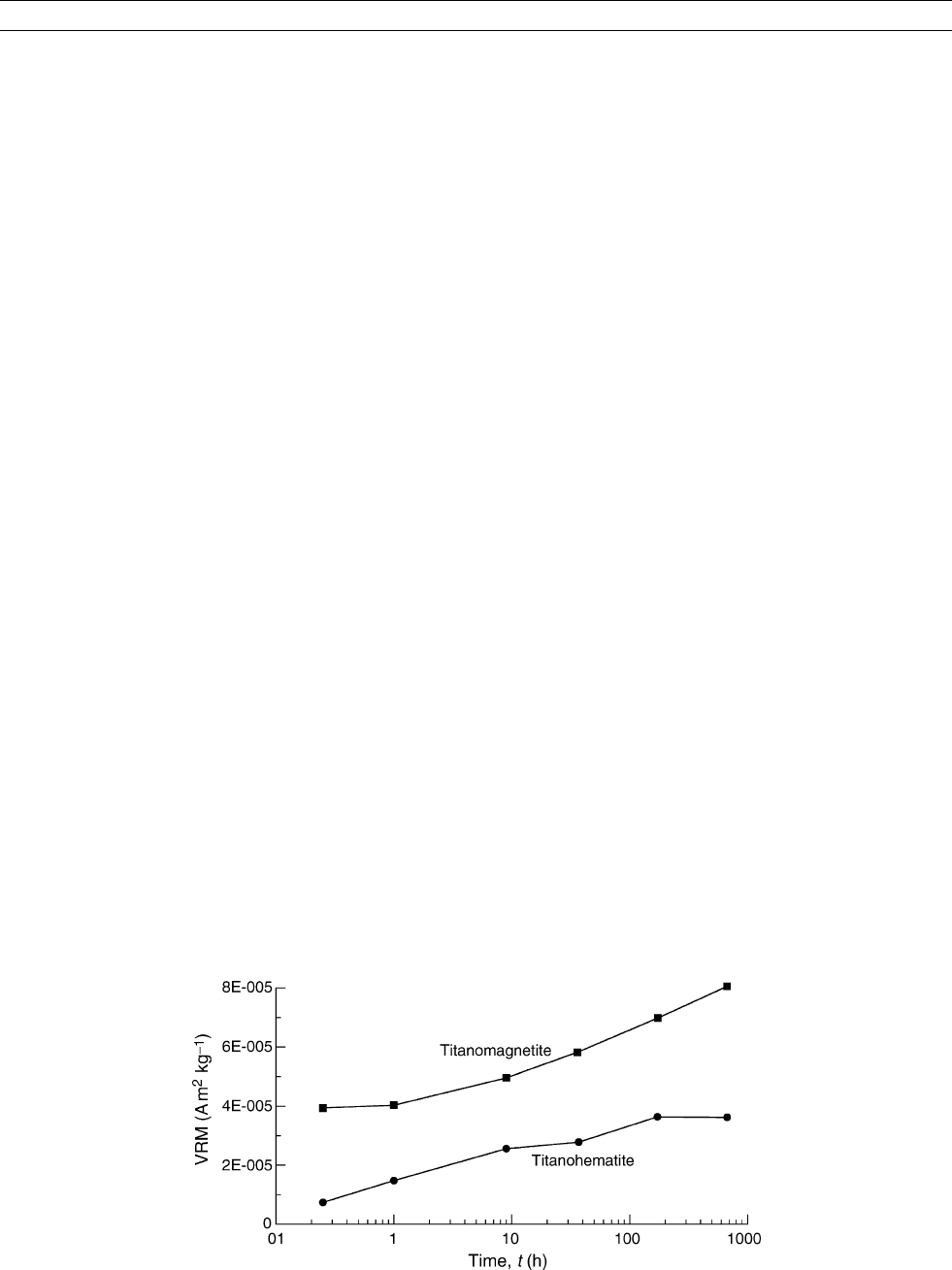
dn=dt ¼½nðtÞn
eq
=t; (Eq. 1)
where the equilibrium value n
eq
/N ¼ tanh(VM
s
H/kT) and the relaxation
time t, due to thermal activation of moments over the energy barrier VK
due to anisotropy, is
1=t ¼ 2f
0
exp½VKðTÞ=kT; (Eq. 2)
with f
0
10
10
s
1
.
At constant temperature, the solution to Eq. (1) is
nðtÞn
eq
¼½nð0Þn
eq
expðt=tÞ; (Eq. 3)
an exponential decay of the out-of-equilibrium distribution function
and magnetization. Néel introduced an approximation that replaces
the real exponential decay by a step function,
nðtÞ¼nð0Þ if t t
nðtÞ¼n
eq
if t > t: (Eq: 4)
In the case of TRM, where t changes rapidly with small changes in T,
Néel’s approximation leads to the definition of the blocking temperature
T
B
, at which the ensemble rapidly passes from a thermal equilibrium
state to an out-of-equilibrium state during cooling, or the reverse during
heating, e.g., in thermal demagnetization. The blocking concept is less
useful in isothermal viscous magnetization because t remains constant
and all changes are a result of changing t.
Any real sample contains many ensembles with different values of V
and K. The grain distribution f (V, K)dV dK is generally poorly deter-
mined, but the formal solution of Eq. (3) for acquisition of magnetic
moment m(t) by all ensembles, starting from a demagnetized state, is
mðtÞ¼
RR
VM
s
n
eq
½1 expðt=tÞ f ðV ; KÞdV dK: (Eq. 5)
Numerical solutions can be found for specified forms of f (V, K).
Time and temperature de pendence of VRM
If f (V, K) is constant or nearly constant over a range of (V, K), the con-
volution of the exponential time dependence for a single ensemble
(Eq. (3)) with f (V, K), as expressed by Eq. (5), leads to a logarithmic
dependence of m(t)ont (see Dunlop, 1973, or Dunlop and Özdemir,
1997, Chapter 10 for details). Experimentally most ferromagnetic
materials on a laboratory timescale exhibit viscous changes that are
indeed approximately proportional to logt. Figure M138 illustrates
the measured time dependence of VRM for oxidized and unoxidized
pyroclastics on a t scale from 15 min to 28 days (about 4 decades of
t). Only a limited range of (V, K) is activated in a few decades of t
and the VRM increases more or less linearly on a logt scale.
According to Eq. (2), for T constant, VK is proportional to log2f
0
t.
Using Néel’s blocking approximation (4), it is then possible to trans-
form f (V, K) directly into the corresponding distribution g(logt). In this
way, one can predict the viscosity coefficient S ¼ @M /@logt for a sam-
ple whose grain distribution f (V, K)isknown.
Another approach (Walton, 1980) is to calculate S directly from
Eq. (5) without explicitly invoking a blocking approximation. If we
replace K by a suitable average value and approximate n
eq
/N by
VM
s
H/kT, since H is small, we find
S ¼
RR
ðM
2
s
H=kTÞðt=tÞ½1 expðt=tÞV
2
NfðV ÞdV : (Eq. 6)
The integrand is of the form x(1–e
x
), with x itself exponential. It
peaks sharply at x ¼ 1ort ¼ t, which is in fact the blocking condition.
All nonexponential factors can be assigned their blocking values, e.g.,
V ! V
B
¼ (kT/K) log2f
0
t, and taken outside the integral, giving
S ¼ Ik
2
NðM
2
s
T
2
=K
3
ÞHðlog 2f
0
tÞ
2
f ½kT=KÞlog 2f
0
t; (Eq. 7)
the integral I being approximately 1.
Assuming that the anisotropy is due to grain shape, so that K(T) /
M
2
s
ðTÞ, and that the grain distribution is uniform over the range of
ensembles affected in time t, we obtain
S ¼ CHðT=M
2
s
Þ
2
ðlog 2f
0
tÞ
2
; (Eq. 8)
whereas if f (V) / 1/V, as for the larger grains in a lognormal distribution,
S ¼ C
0
HðT=M
2
s
Þ
2
log 2f
0
t; (Eq. 9)
C, C
0
being constants. Either Eq. (8) or (9) predicts a logt dependence
for VRM intensity over times short enough that logt log2f
0
23.7,
i.e., for a few decades of t, as observed. Deviations from logt depen-
dence will become obvious even at short times for very viscous sam-
ples, which scan larger fractions of the grain distribution, and at
longer times for all samples. Deviations will appear earlier if Eq. (8)
applies rather than Eq. (9).
VRM of multidomain and interacting grains
Viscous magnetization due to thermal activation of domain walls has
been treated theoretically in the weak-field limit by Néel and in the
Figure M138 Viscous remanent magnetization measured after exposure times of 15 min to 4 weeks to a 200 mT field (data: Saito et al.,
2003). Upper curve, unoxidized pyroclastic sample containing large grains of titanomagnetite. Lower curve, oxidized pyroclastic
containing hematite and titanohematite.
622 MAGNETIZATION, VISCOUS REMANENT (VRM)

presence of self-demagnetizing fields by Stacey (see Dunlop, 1973, for
a review). All theories predict a logt dependence of VRM for
geologically short times. The viscosity coefficient S varies with tem-
perature as T/M
s
or (T/M
s
)
1/2
. The theories resemble single-domain
formulations with V in Eq. (2) replaced by the volume V
act
activated
in a single Barkhausen jump. The frequency constant f
0
is 10
10
s
1
, as for single-domain grains. Viscous magnetization due to activa-
tion of entire walls should be negligible because V
act
V of a single-
domain grain. It must be that segments of walls are activated past single
pinning sites.
In nature, titanomagnetite and pyrrhotite crystals sometimes fail to
renucleate equilibrium domain structures following saturation, result-
ing from heating to the Curie temperature. A possible mechanism for
multidomain viscous magnetization is thermally activated nucleation
of domains in parts of the crystal where the internal field is close to
the critical nucleation field. This process has been termed transdomain
VRM. Nucleation events have been observed in magnetite during small
changes of T (Heider et al., 1988) but are not yet documented for
changing t at constant T.
Interacting single-domain grains have been approached in two dif-
ferent ways. One method is to treat them collectively by increasing
V from the single-grain value. This approach preserves the experimen-
tally observed logt behavior but it is not known at what level of inter-
action the picture breaks down. Another approach is to deal with
individual particles under the influence of a randomly varying interac-
tion field. Walton and Dunlop (1985) predicted deviation from logt
behavior when the interactions are strong. Their theory gave a good
fit to viscous magnetization data for an interacting single-domain
assemblage with known f (V).
Experimental results
Grain size dependence of viscosity coefficients
Room-temperature viscosity coefficients S have their highest values in
single-domain grains with volumes V just above the critical superpar-
amagnetic volume V
B
. Figure M139 illustrates the data for magnetite.
Data sets for other minerals are even smaller. Between the magnetite
critical superparamagnetic size (0.025–0.03 mm) and the maximum
size for single-domain behavior (0.07–0.08 mm), S decreases by at
least a factor 4. The decrease may actually be larger and more precipitous
than shown. Even in carefully sized samples, there is always a fraction of
very fine grains. This fine fraction probably controls the short-term vis-
cous behavior, because, according to Eqs. (2) and (4), only grains with
very small V will be activated in the short times used in laboratory
experiments. Similar “contaminating” ultrafine grains may explain the
constant baseline value of S in grains larger than single-domain size.
The twofold increase in S over the upper pseudosingle-domain
region (2–15 mm) is probably real and due to the increasing ease with
which segments of walls can escape from their pins as the scale
of the domains grows. On the other hand, large multidomain grains
80–100 mm in mean size have significantly lower S values.
In summary, strong viscous magnetization is found mainly in the
finest single-domain grains. However, small multidomain (so-called
pseudosingle-domain) grains are also significantly viscous.
Observations on lunar rocks and soils (see Dunlop, 1973 and
Dunlop and Özdemir, 1997, Chapter 17 for summaries) confirm this
trend. Lunar soils and loosely welded soil breccias containing nearly
superparamagnetic iron particles are among the most viscous materials
known, whereas crystalline rocks and mature breccias containing mul-
tidomain iron exhibit a consistent but small viscous magnetization.
The viscous nature of lunar samples greatly complicated the study of
their other magnetic properties during the Apollo missions.
Temperature dependence of viscous magnetization
Viscous magnetization data for a single-domain magnetite sample
(mean grain size 0.037 mm) at and above room temperature appear
in Figure M140. Zeroing the field H for each measurement would have
changed the initial state for subsequent measurements. Therefore vis-
cous induced magnetization in the presence of H was measured.
Over the short time-spans examined (2.4 decades of t), M
vr
is linear
in logt, as predicted by Eqs. (2), (8), and (9). The viscosity coefficient
S, the slope of each data run, increases steadily with increasing T. This
too is as predicted by theory. However, the inherent temperature
dependence of S,inEqs. (8) and (9) for example, tends to be obscured
by the variability of the grain distribution f (V, K), which is scanned with
a narrow thermal “window,” as expressed by the factor f (kT/K)log2f
0
t]
in Eq. (7).
Very different temperature dependences of viscous magnetization
have been reported for magnetite and titanomagnetites of various grain
sizes by different authors. In many cases, the higher-T results are dis-
tinctly nonlinear in logt. However, a good theoretical match is evident
in Figure M140 between the single-domain magnetite data (Dunlop,
1983) and the theory of equations (6)–(9), using the measured f (V)
of this sample (Walton, 1983).
Field dependence of viscous magnetization
Experiments confirm the theoretical prediction (e.g., Eqs. (6)–(9)) that
VRM intensity is proportional to field strength H for weak fields. The most
detailed studies are those of Creer (1957) on single-domain hematite and
Le Borgne (1960) on soils containing single-domain magnetite and
maghemite. Linear behavior was observed for 0.05 mT H 1mT.
Figure M139 Viscosity coefficients S for sized grains of magnetite. Data: triangles, Shimizu (1960); circles, Dunlop (1983); squares,
Tivey and Johnson (1984).
MAGNETIZATION, VISCOUS REMANENT (VRM) 623
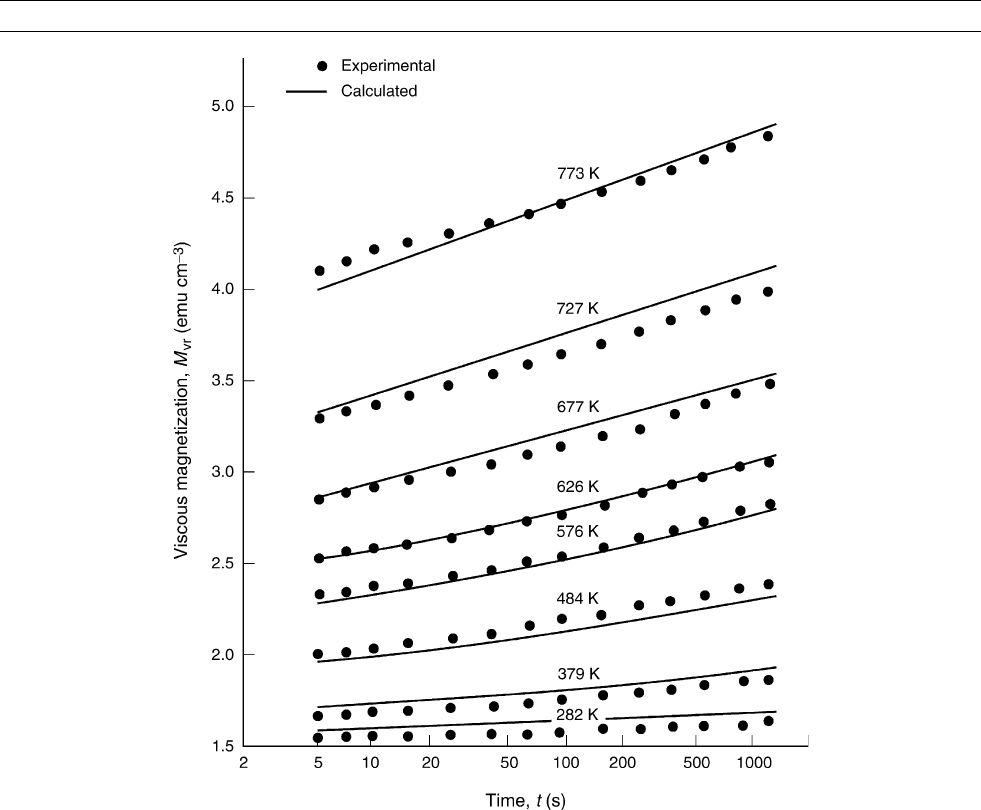
Viscous magnetization at short times: frequency
dependent and quadrature susceptibility
Viscous changes in magnetization can be detected over very short
times by measuring initial susceptibility w (short-term induced M, nor-
malized by H) as a function of the frequency f of an alternating field
(AF)
~
H. In effect, each cycle of the AF restarts the viscous magnetiza-
tion experiment. A second method is to measure the quadrature (90
out-of-phase) component of susceptibility w
q
, which represents a
time-delayed response to
~
H.
In the classic experiments of Mullins and Tite (1973) on soils containing
single-domain size magnetite and maghemite, @w/@logf and w
q
were con-
stant over the tested range of f (66–900 Hz, 1.4 decades of t). No frequency
dependence or quadrature susceptibility was detected for multidomain
magnetite.
A pair of measurements of w at two standard frequencies is routinely
used in environmental magnetic studies as a test for the presence of
nearly superparamagnetic magnetite or maghemite. Because the fre-
quencies are preset, there is no attempt to tune the viscosity measure-
ment to other minerals or to domain states other than single-domain.
Much more granulometric information could be obtained with a little
extra effort by scanning a wider range of f and by extending the
measurements to temperatures other than room temperature
(e.g., Jackson and Worm, 2001).
Demagnetizing VRM
AF demagnetization
The AFs
~
H used in frequency-dependent susceptibility measurements
have small amplitudes, usually 0.1 mT, and do not seriously modify
preexisting remanences. If larger AFs are applied, they entrain single-
domain moments or domain walls, causing them to oscillate and
destroy VRM (or any other remanence, for sufficiently large
~
H). To
demagnetize a previously magnetized sample,
~
H is slowly decreased
from its maximum value at a rate f, leaving about equal numbers of
moments or domains in one or the other polarity. AF demagnetization
is carried out in a stepwise fashion. The maximum field is increased
in steps, starting from small values, so as to gradually erase remanence
components of increasing AF coercivity.
VRM is often the NRM component of lowest coercivity and there-
fore erased first. Indeed the strategy of AF cleaning in paleomagnetism
is firmly rooted in this assumption.
Figure M140 Viscous magnetization of a single-domain magnetite sample (mean grain size 0.037 mm) at various temperatures.
Dots: measured results, Dunlop (1983); lines: theoretical fits, Walton (1983).
624 MAGNETIZATION, VISCOUS REMANENT (VRM)
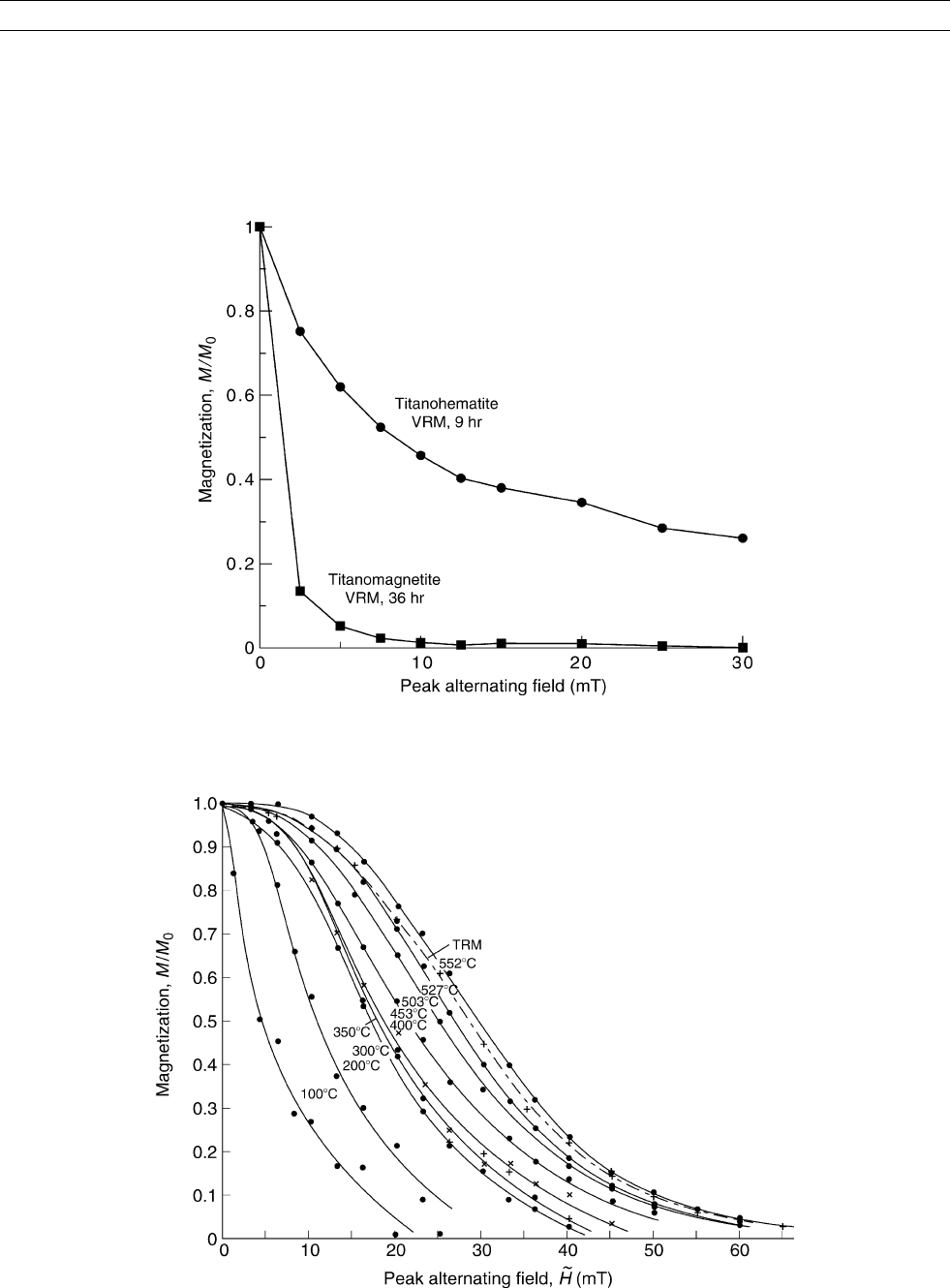
Strong fields lower the energy barrier VK to rotation of single-domain
moments or the corresponding “barrier” (pinning energy) for domain
wall motion. In the single-domain case, Eq. (2) is modified to
1=t
H
¼ f
0
exp½ðVKðTÞ=kTÞð1 M
s
H=2KÞ
2
: (Eq. 10)
One consequence is hard VRM in minerals with high K/M
s
, like
hematite, goethite, pyrrhotite, elongated single-domain iron, and
many compositions of titanomagnetite, titanomaghemite, and titanohe-
matite. VRM is produced by a weak field and Eq. (2) applies, but it
is demagnetized by a strong field
~
H for which Eq. (10) is
Figure M141 AF demagnetization of some of the VRMs of Figure M138 (data: Saito et al., 2003). VRM of the unoxidized
titanomagnetite is erased by 2.5 mT. VRM of the oxidized sample containing titanohematite is much more resistant.
Figure M142 AF demagnetization of VRMs produced by 2.5 h exposure to a 50 mT field at the temperatures shown (after Dunlop and
O
¨
zdemir, 1990). VRMs produced at higher temperatures are increasingly resistant to AF cleaning.
MAGNETIZATION, VISCOUS REMANENT (VRM) 625
